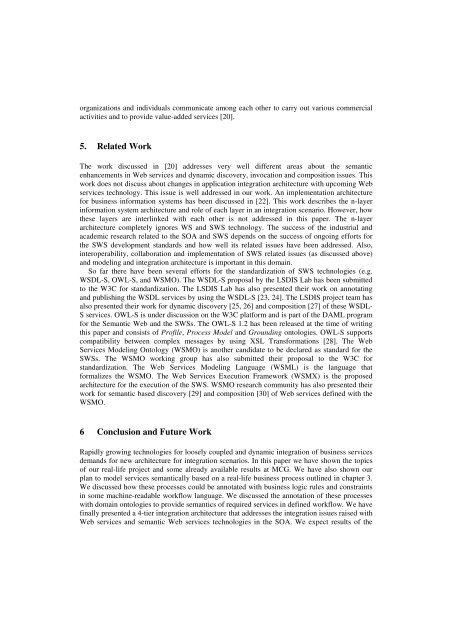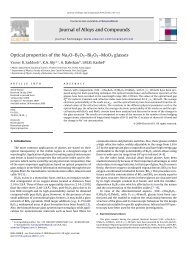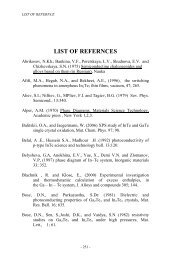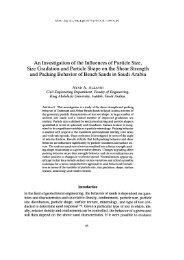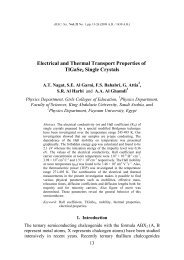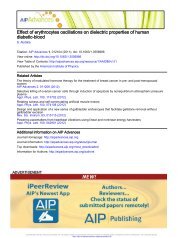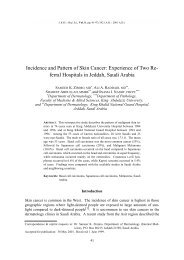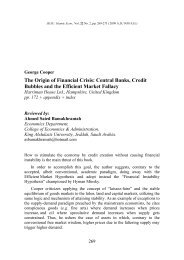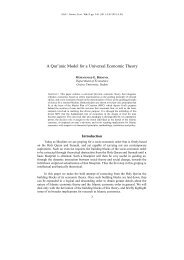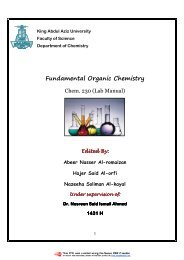Real-life SOA Experiences and an Approach Towards Semantic SOA
Real-life SOA Experiences and an Approach Towards Semantic SOA
Real-life SOA Experiences and an Approach Towards Semantic SOA
You also want an ePaper? Increase the reach of your titles
YUMPU automatically turns print PDFs into web optimized ePapers that Google loves.
org<strong>an</strong>izations <strong><strong>an</strong>d</strong> individuals communicate among each other to carry out various commercial<br />
activities <strong><strong>an</strong>d</strong> to provide value-added services [20].<br />
5. Related Work<br />
The work discussed in [20] addresses very well different areas about the sem<strong>an</strong>tic<br />
enh<strong>an</strong>cements in Web services <strong><strong>an</strong>d</strong> dynamic discovery, invocation <strong><strong>an</strong>d</strong> composition issues. This<br />
work does not discuss about ch<strong>an</strong>ges in application integration architecture with upcoming Web<br />
services technology. This issue is well addressed in our work. An implementation architecture<br />
for business information systems has been discussed in [22]. This work describes the n-layer<br />
information system architecture <strong><strong>an</strong>d</strong> role of each layer in <strong>an</strong> integration scenario. However, how<br />
these layers are interlinked with each other is not addressed in this paper. The n-layer<br />
architecture completely ignores WS <strong><strong>an</strong>d</strong> SWS technology. The success of the industrial <strong><strong>an</strong>d</strong><br />
academic research related to the <strong>SOA</strong> <strong><strong>an</strong>d</strong> SWS depends on the success of ongoing efforts for<br />
the SWS development st<strong><strong>an</strong>d</strong>ards <strong><strong>an</strong>d</strong> how well its related issues have been addressed. Also,<br />
interoperability, collaboration <strong><strong>an</strong>d</strong> implementation of SWS related issues (as discussed above)<br />
<strong><strong>an</strong>d</strong> modeling <strong><strong>an</strong>d</strong> integration architecture is import<strong>an</strong>t in this domain.<br />
So far there have been several efforts for the st<strong><strong>an</strong>d</strong>ardization of SWS technologies (e.g.<br />
WSDL-S, OWL-S, <strong><strong>an</strong>d</strong> WSMO). The WSDL-S proposal by the LSDIS Lab has been submitted<br />
to the W3C for st<strong><strong>an</strong>d</strong>ardization. The LSDIS Lab has also presented their work on <strong>an</strong>notating<br />
<strong><strong>an</strong>d</strong> publishing the WSDL services by using the WSDL-S [23, 24]. The LSDIS project team has<br />
also presented their work for dynamic discovery [25, 26] <strong><strong>an</strong>d</strong> composition [27] of these WSDL-<br />
S services. OWL-S is under discussion on the W3C platform <strong><strong>an</strong>d</strong> is part of the DAML program<br />
for the Sem<strong>an</strong>tic Web <strong><strong>an</strong>d</strong> the SWSs. The OWL-S 1.2 has been released at the time of writing<br />
this paper <strong><strong>an</strong>d</strong> consists of Profile, Process Model <strong><strong>an</strong>d</strong> Grounding ontologies. OWL-S supports<br />
compatibility between complex messages by using XSL Tr<strong>an</strong>sformations [28]. The Web<br />
Services Modeling Ontology (WSMO) is <strong>an</strong>other c<strong><strong>an</strong>d</strong>idate to be declared as st<strong><strong>an</strong>d</strong>ard for the<br />
SWSs. The WSMO working group has also submitted their proposal to the W3C for<br />
st<strong><strong>an</strong>d</strong>ardization. The Web Services Modeling L<strong>an</strong>guage (WSML) is the l<strong>an</strong>guage that<br />
formalizes the WSMO. The Web Services Execution Framework (WSMX) is the proposed<br />
architecture for the execution of the SWS. WSMO research community has also presented their<br />
work for sem<strong>an</strong>tic based discovery [29] <strong><strong>an</strong>d</strong> composition [30] of Web services defined with the<br />
WSMO.<br />
6 Conclusion <strong><strong>an</strong>d</strong> Future Work<br />
Rapidly growing technologies for loosely coupled <strong><strong>an</strong>d</strong> dynamic integration of business services<br />
dem<strong><strong>an</strong>d</strong>s for new architecture for integration scenarios. In this paper we have shown the topics<br />
of our real-<strong>life</strong> project <strong><strong>an</strong>d</strong> some already available results at MCG. We have also shown our<br />
pl<strong>an</strong> to model services sem<strong>an</strong>tically based on a real-<strong>life</strong> business process outlined in chapter 3.<br />
We discussed how these processes could be <strong>an</strong>notated with business logic rules <strong><strong>an</strong>d</strong> constraints<br />
in some machine-readable workflow l<strong>an</strong>guage. We discussed the <strong>an</strong>notation of these processes<br />
with domain ontologies to provide sem<strong>an</strong>tics of required services in defined workflow. We have<br />
finally presented a 4-tier integration architecture that addresses the integration issues raised with<br />
Web services <strong><strong>an</strong>d</strong> sem<strong>an</strong>tic Web services technologies in the <strong>SOA</strong>. We expect results of the


